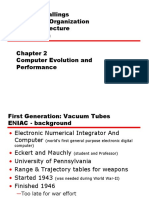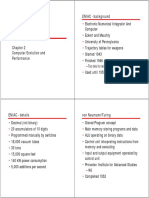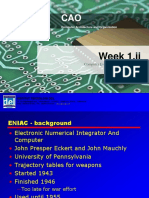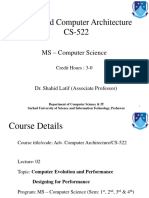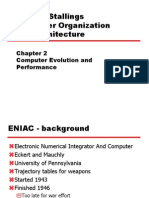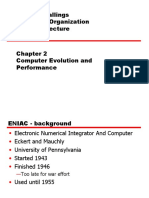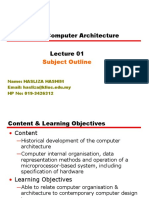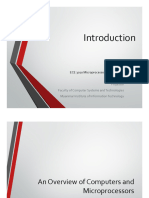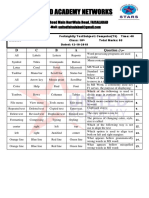William Stallings Computer Organization and Architecture 8th Edition Chapter 2 p Computer Evolution and Performance
ENIAC - background Electronic Numerical Integrator And Computer Eckert and Mauchly University of Pennsylvania Trajectory tables for weapons Started 1943 Finished 1946
Too late for war effort
Used until 1955
ENIAC - details Decimal (not binary) 20 accumulators of 10 digits Programmed manually by switches 18,000 vacuum tubes 30 tons 15,000 square feet 140 kW power consumption 5,000 additions per second
von Neumann/Turing Stored Program concept Main memory storing programs and data ALU operating on binary data Control unit interpreting instructions from memory and executing Input and output equipment operated by control unit Princeton Institute for Advanced Studies
IAS
Completed 1952
Structure of von Neumann machine
IAS - details 1000 x 40 bit words
Binary number 2 x 20 bit instructions
Set of registers (storage in CPU)
Memory Buffer Register Memory Address Register Memory Instruction Register Instruction Buffer Register Program Counter Accumulator Multiplier Quotient
�Structure of IAS detail
Commercial Computers 1947 - Eckert-Mauchly Computer Corporation UNIVAC I (Universal Automatic Computer) US Bureau of Census 1950 calculations Became part of Sperry-Rand Corporation Sperry Rand Late 1950s - UNIVAC II
Faster More memory
IBM Punched-card processing equipment 1953 - the 701
IBMs first stored program computer Scientific calculations
Transistors Replaced vacuum tubes Smaller Cheaper Less heat dissipation Solid State device Made from Silicon (Sand) Invented 1947 at Bell Labs William Shockley et al.
1955 - the 702
Business applications
Lead to 700/7000 series
Transistor Based Computers Second generation machines NCR & RCA produced small transistor machines IBM 7000 DEC - 1957
Produced PDP-1
Microelectronics Literally - small electronics A computer is made up of gates, memory cells and interconnections These can be manufactured on a semiconductor e.g. silicon wafer
�Generations of Computer Vacuum tube - 1946-1957 Transistor - 1958-1964 Small scale integration - 1965 on
Up to 100 devices on a chip
Moores Law
Increased density of components on chip Gordon Moore co-founder of Intel Number of transistors on a chip will double every year Since 1970s development has slowed a little
Number of transistors doubles every 18 months
Medium scale integration - to 1971
100-3,000 devices on a chip 100 3 000 d i hi
Large scale integration - 1971-1977
3,000 - 100,000 devices on a chip
Very large scale integration - 1978 -1991
100,000 - 100,000,000 devices on a chip
Ultra large scale integration 1991 Over 100,000,000 devices on a chip
Cost of a chip has remained almost unchanged Higher packing density means shorter electrical paths, giving higher performance Smaller size gives increased flexibility Reduced power and cooling requirements Fewer interconnections increases reliability
Growth in CPU Transistor Count
IBM 360 series 1964 Replaced (& not compatible with) 7000 series First planned family of computers
Similar or identical Similar or identical Increasing speed Increasing number terminals) Increased memory Increased cost instruction sets O/S of I/O ports (i.e. more size
Multiplexed switch structure
DEC PDP-8 1964 First minicomputer (after miniskirt!) Did not need air conditioned room Small enough to sit on a lab bench $16,000 $16 000
$100k+ for IBM 360
DEC - PDP-8 Bus Structure
Embedded applications & OEM BUS STRUCTURE
�Semiconductor Memory 1970 Fairchild Size of a single core
i.e. 1 bit of magnetic core storage
Intel 1971 - 4004
First microprocessor All CPU components on a single chip 4 bit
Holds 256 bits Non-destructive read Much faster than core Capacity approximately doubles each year
Followed in 1972 by 8008
8 bit Both designed for specific applications
1974 - 8080
Intels first general purpose microprocessor
Performance Balance Processor speed increased Memory capacity increased Memory speed lags behind processor speed
Speeding it up Pipelining On board cache On board L1 & L2 cache Branch prediction Data flow analysis Speculative execution
Logic and Memory Performance Gap
Solutions Increase number of bits retrieved at one time
Make DRAM wider rather than deeper
Change DRAM interface
Cache
Reduce frequency of memory access
More complex cache and cache on chip
Increase interconnection bandwidth
High speed buses Hierarchy of buses
�I/O Devices Peripherals with intensive I/O demands Large data throughput demands Processors can handle this Problem moving data Solutions:
Caching Buffering Higher-speed interconnection buses More elaborate bus structures Multiple-processor configurations
Typical I/O Device Data Rates
Key is Balance Processor components Main memory I/O devices Interconnection structures
Improvements in Chip Organization and Architecture Increase hardware speed of processor
Fundamentally due to shrinking logic gate size
More gates, packed more tightly, increasing clock rate Propagation time for signals reduced
Increase size and speed of caches
Dedicating part of processor chip
Cache access times drop significantly
Change processor organization and architecture
Increase effective speed of execution Parallelism
Problems with Clock Speed and Logic Density
Power
Power density increases with density of logic and clock speed Dissipating heat
Intel Microprocessor Performance
RC delay
Speed at which electrons flow limited by resistance and capacitance of metal wires connecting them it f t l i ti th Delay increases as RC product increases Wire interconnects thinner, increasing resistance Wires closer together, increasing capacitance
Memory latency
Memory speeds lag processor speeds
Solution:
More emphasis on organizational and architectural approaches
�Increased Cache Capacity Typically two or three levels of cache between processor and main memory Chip density increased
More cache memory on chip
Faster cache access
More Complex Execution Logic Enable parallel execution of instructions Pipeline works like assembly line
Different stages of execution of different instructions at same time along pipeline
Pentium chip devoted about 10% of chip area to cache Pentium 4 devotes about 50%
Superscalar allows multiple pipelines within single processor
Instructions that do not depend on one another can be executed in parallel
Diminishing Returns Internal organization of processors complex
Can get a great deal of parallelism Further significant increases likely to be relatively modest
New Approach Multiple Cores
Multiple processors on single chip
Large shared cache
B Benefits from cache are reaching limit fit f h hi li it Increasing clock rate runs into power dissipation problem
Some fundamental physical limits are being reached
Within a processor, increase in performance proportional to square root of increase in complexity p processors, doubling , g If software can use multiple p number of processors almost doubles performance So, use two simpler processors on the chip rather than one more complex processor With two processors, larger caches are justified
Power consumption of memory logic less than processing logic
x86 Evolution (1)
8080 first general purpose microprocessor 8 bit data path Used in first personal computer Altair 8086 5MHz 29,000 transistors much more powerful 16 bit s uc o cac e, p e e c e s uc o s instruction cache, prefetch few instructions 8088 (8 bit external bus) used in first IBM PC 80286 16 Mbyte memory addressable up from 1Mb 80386 32 bit Support for multitasking 80486 sophisticated powerful cache and instruction pipelining built in maths co-processor
x86 Evolution (2)
Pentium
Superscalar Multiple instructions executed in parallel
Pentium Pro
Increased superscalar organization Aggressive register renaming p branch prediction data flow analysis speculative execution
Pentium II
MMX technology graphics, video & audio processing
Pentium III
Additional floating point instructions for 3D graphics
�x86 Evolution (3)
Pentium 4
Note Arabic rather than Roman numerals Further floating point and multimedia enhancements
Embedded Systems ARM
ARM evolved from RISC design Used mainly in embedded systems
Used within product Not general purpose computer Dedicated function E.g. Anti-lock brakes in car
Core
First x86 with dual core
Core 2
64 bit architecture
Core 2 Quad 3GHz 820 million transistors
Four processors on chip x86 architecture dominant outside embedded systems Organization and technology changed dramatically Instruction set architecture evolved with backwards compatibility ~1 instruction per month added 500 instructions available See Intel web pages for detailed information on processors
Embedded Systems Requirements Different sizes
Different constraints, optimization, reuse
Possible Organization of an Embedded System
Different requirements
Safety, reliability, real-time, flexibility, legislation Lifespan Environmental conditions Static v dynamic loads Slow to fast speeds Computation v I/O intensive Descrete event v continuous dynamics
ARM Evolution Designed by ARM Inc., Cambridge, England Licensed to manufacturers High speed, small die, low power consumption PDAs, hand held games, phones
E.g. iPod, iPhone
ARM Systems Categories Embedded real time Application platform
Linux, Palm OS, Symbian OS, Windows mobile
Secure applications
Acorn produced ARM1 & ARM2 in 1985 and ARM3 in 1989 Acorn, VLSI and Apple Computer founded ARM Ltd.
�Performance Assessment Clock Speed Key parameters
Performance, cost, size, security, reliability, power consumption
System Clock
System clock speed
In Hz or multiples of Clock rate, clock cycle, clock tick, cycle time
Signals in CPU take time to settle down to 1 or 0 Signals may change at different speeds Operations need to be synchronised Instruction execution in discrete steps
Fetch, decode, load and store, arithmetic or logical Usually require multiple clock cycles per instruction
Pipelining gives simultaneous execution of instructions So, clock speed is not the whole story
Instruction Execution Rate Millions of instructions per second (MIPS) Millions of floating point instructions per second (MFLOPS) Heavily dependent on instruction set, compiler design, processor implementation, cache & memory hierarchy
Benchmarks
Programs designed to test performance Written in high level language
Portable
Represents style of task
Systems, numerical, commercial
Easily measured Widely distributed E.g. System Performance Evaluation Corporation (SPEC)
CPU2006 for computation bound
17 floating point programs in C, C++, Fortran 12 integer programs in C, C++ 3 million lines of code
Speed and rate metrics
Single task and throughput
SPEC Speed Metric
Single task Base runtime defined for each benchmark using reference machine Results are reported as ratio of reference time to system run time
Trefi execution time for benchmark i on reference machine Tsuti execution time of benchmark i on test system
SPEC Rate Metric
Measures throughput or rate of a machine carrying out a number of tasks Multiple copies of benchmarks run simultaneously
Typically, same as number of processors
Ratio is calculated as follows:
Trefi reference execution time for benchmark i N number of copies run simultaneously Tsuti elapsed time from start of execution of program on all N processors until completion of all copies of program Again, a geometric mean is calculated
Overall performance calculated by averaging ratios for all 12 integer benchmarks
Use geometric mean Appropriate for normalized numbers such as ratios
�Amdahls Law Gene Amdahl [AMDA67] Potential speed up of program using multiple processors Concluded that:
Code needs to be parallelizable p Speed up is bound, giving diminishing returns for more processors
Amdahls Law Formula
For program running on single processor
Fraction f of code infinitely parallelizable with no scheduling overhead Fraction (1-f) of code inherently serial T is total execution time for program on single processor N is number of processors that fully exploit parralel portions of code
Task dependent
Servers gain by maintaining multiple connections on multiple processors Databases can be split into parallel tasks Conclusions
f small, parallel processors has little effect N ->, speedup bound by 1/(1 f)
Diminishing returns for using more processors
Internet Resources http://www.intel.com/
Search for the Intel Museum
References AMDA67 Amdahl, G. Validity of the Single-Processor Approach to Achieving Large-Scale Computing Capability, Proceedings of the AFIPS Conference, 1967.
http://www.ibm.com http://www.dec.com Charles Babbage Institute PowerPC Intel Developer Home
